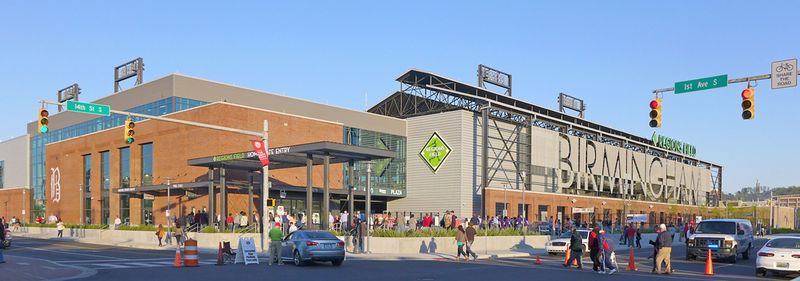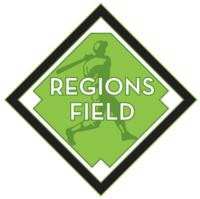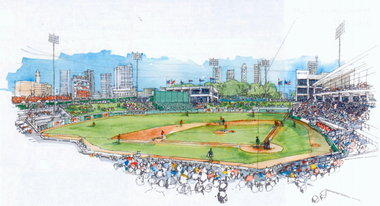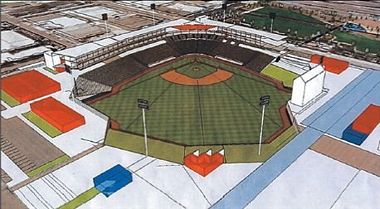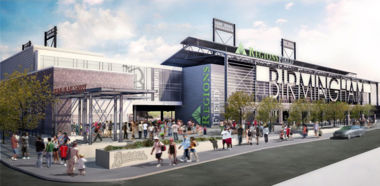Regions Field: Difference between revisions
No edit summary |
No edit summary |
||
| (38 intermediate revisions by 3 users not shown) | |||
| Line 1: | Line 1: | ||
[[Image: | [[Image:Regions Field.jpg|center|thumb|800px|Regions Field in April 2014]] | ||
[[Image:Regions Field logo.png|right|200px]] | |||
'''Regions Field''' is an 8,500-seat baseball stadium constructed in [[2013]] for the [[Birmingham Barons]] adjoining [[Railroad Park]] in [[downtown Birmingham]]. | |||
==Conception== | |||
The Barons, established in [[1885]], had moved out of the city in [[1987]] after the City of [[Hoover]] constructed a [[Hoover Metropolitan Stadium|new ballpark]] and Birmingham leaders declined to invest in major upgrades to [[Rickwood Field]]. | |||
The idea of building a new downtown ballpark had been discussed from the time that [[Don Logan]] and his son [[Stan Logan|Stan]] purchased the team in [[2005]], and was jump-started by [[Robert Simon]] of [[Corporate Realty Development]] in [[2009]]. CRD commissioned a feasibility and economic impact study, which indicated that such a facility and surrounding development could be a boon to the downtown area. Mayor [[William Bell]] pursued the project and proposed increasing the city's lodging tax by 3.5% to fund construction. His funding plan was approved by the [[Birmingham City Council]] on [[October 26]], [[2010]], and the city signed a tentative agreement with Barons owners [[Don Logan|Don]] and [[Stan Logan]] to relocate the team on [[November 4]]. | |||
[[Image:Downtown ballpark rendering.jpg|left|thumb|380px|CRD's rendering, included in their 2009 feasibility study]] | |||
The site considered most advantageous at that time was a four-block area which included the [[Merita Bakery]], between [[I-65]] and the [[Railroad Park]]. Bell proposed making the ballpark a publicly-funded anchor for a major [[Downtown revitalization|revitalization]] of the area between the Railroad Park and the [[Trinity Park]] site in [[North Titusville]], now a brownfield owned by the [[Jefferson County Economic and Industrial Development Authority]]. The area, which crosses [[I-65]], has been targeted for development of a green corridor paralleling the [[Railroad Reservation]]. The larger plan was dubbed the "[[Parkside District]]" in Bell's announcement. Private development of mixed-use residential, restaurant and retail space would be supported by master planning work, infrastructure upgrades and economic incentives provided by the city. | |||
With the possibility that a stadium could be constructed in Birmingham as soon as [[2012]], Hoover Mayor [[Tony Petelos]] told the press that his city had invested $6 million in improvements at Regions Park and would not be amenable to signing a short-term lease with the Barons that would allow the team to move before [[2016]]. The Barons did sign a five-year lease in late 2010, breaking it in order to move before the [[2013 Birmingham Barons|2013 season]]. | |||
In | In mid-December, the City Council approved a commercial property appraisal for the preferred site. Bell disclosed that the Titusville end of the Parkside District was off the table for the ballpark because of the difficulty of connecting it, across I-65, to the Railroad Park in the first phases of redevelopment. The possibility of building the baseball facility near the [[BJCC]] was mentioned as an alternative plan. | ||
In July [[2011]] Bell submitted a package of contracts to the City Council that included a land-swap with [[UAB]] to acquire a large parcel between [[14th Street South|14th]] and [[16th Street South|16th Streets]], just south of the Railroad Park site. Plans publicized at the time included public parking and possible sites for an entrance plaza and entertainment district south of the park, on axis with [[15th Street South]]. [[William Mudd]], owner of the [[B & A Warehouse]], objected to the proposed site, which would eradicate his business. He later reached an agreement with Logan to incorporate the business into the design of the stadium. | |||
In | |||
The proposal approved by the City Council established a "Public Athletic Cultural and Entertainment Facilities Board" which would function as the bond-issuing authority. $63 million in private placement bonds were secured through [[BBVA Compass]] and [[Citizens Trust Bank]] in December [[2011]] to finance construction of the stadium, an associated [[Negro Leagues Museum]], as well as surrounding street and infrastructure improvements and public incentives for private development. | |||
==Design== | |||
[[Image:Downtown ballpark rendering 12-2011.jpg|left|thumb|380px|December 2011 rendering of the proposed ballpark]] | |||
[[Image:Regions Field rendering.jpg|left|thumb|380px|2012 rendering showing the 14th Street side of Regions Field]] | |||
Conjectured designs for a downtown ballpark were included in CRD's feasibility study. Other speculative design work was done independently by architect [[Craig Krawczyk]], who chose a site near the [[Civil Rights District]] to take advantage of better views to the city's [[List of buildings by height|skyline]] and existing amenities in the [[theater district]]. | |||
Once the city's lodging tax increase was passed, the mayor's office contracted [[GA Studio]] and former GA architect [[Creig Hoskins]] to partner with Dallas, Texas-based HKS Architects on the stadium design. Early site plans given to the press showed home plate in the south corner of the park, giving infield seats a wide view of the financial district skyline, but also leaving a potentially blank outfield wall to face the Railroad Park and requiring development of a new entrance plaza facing [[Midtown district|midtown]]. When demolition of existing structures on the site went before the [[Birmingham Design Review Committee]], a revised site plan was shown, indicating that home plate would be on the west corner of the site, with views of downtown from the right field stands and view of [[Southside]] and [[Red Mountain]] from down the 3rd base line. | |||
CRD's Simon indicated that the final architectural design would "pay homage" to the city's industrial heritage and include brick and steel. Architects drew inspiration from [[Rickwood Field]], [[Sloss Furnaces]] and other landmarks. The site plan and exterior design of the park was approved by the Design Review Committee on [[March 14]], [[2012]]. Outfield dimensions for the park were set at 320 feet to left, 400 feet to center and 325 feet to right, with 12-foot walls dropping to 8 feet in center field. | |||
The stadium features luxury suites with roll-up doors, a large banquet hall over the South concourse, a continuous public space around the outfield with grassy slopes and picnic tables, and a large team store which is set to be open year-round. | |||
The city's ambitious schedule for construction put completion in advance of opening day of the [[2013 Birmingham Barons|Barons season]] on [[April 10]], [[2013]]. | |||
==Construction== | |||
A ceremonial groundbreaking for the park was held on [[February 2]], [[2012]], with an announcement that [[Regions Bank]] would be the facility's title sponsor. Demolition and site work began in earnest shortly thereafter. | |||
An "open house" for the public to see the stadium under construction was held on Sunday, [[January 23]], 2013. At that time most of the superstructure was framed in and concrete tiers for seating areas poured. Subgrading for the field and installation of a large video-screen scoreboard took place within a few days. The stadium logo was also unveiled in January. | |||
During construction, a large [[sinkhole]] was discovered below the plaza entrance at [[15th Street South|15th Street]] and [[3rd Avenue South]]. The site conditions were repaired under the project's contingency budget, but required a re-routing of sewer lines. In February, Regions Field's west entrance plaza was chosen as the site for one of five gaslights installed by [[Alagasco]] in honor of the [[50 Years Foreward|50th Anniversary]] of the pivotal events in the [[Civil Rights Movement]] in Alabama. | |||
The sinkhole and weather-related delays resulted in construction cost overruns amounting to about $8 million. After negotiation with the Mayor's office, [[Robins & Morton]] and [[A. G. Gaston Construction]] agreed to split the cost of the overruns, but the [[Birmingham City Council]] balked at the $4.1 million request for additional funds it had not approved. Eventually, after a closed-door meeting, the Council agreed to pay off the debt in installments scheduled to continue through [[2021]]. | |||
==Operation== | |||
Opening day for Regions Field took place on [[April 10]], [[2013]], with some stadium amenities and work on the 3rd Avenue entranceway still incomplete. Governor [[Robert Bentley]] attended the ribbon-cutting, and Mayor [[William Bell]] threw the first pitch. A sellout crowd watched the Barons beat the Mississippi Braves, 9-5. [[Nolan Lyda]] caught the Barons' first home-run ball in Regions Field, which [[Marcus Semien]] sent past the left center field wall in the bottom of the fifth. Opening day snafus included long lines at concession stands, some confusion over reserved tickets sold for what turned out to be wheelchair spaces, and an audio glitch during the singing of the National Anthem. Most fans, however, were impressed and excited about the new facility. | |||
Birmingham's deal with the Barons organization gives the team control of concessions and a majority of ticket and suite revenue, estimated beforehand at around $3.7 million per year. The city receives $2,500 per annual suite lease, $1 per ticket sold over 200,000 per year, and 10% of the gate for Barons' special events. Regions Bank's $500,000/year deal for naming rights is split between the team and the city. | |||
The "Dreamland Big Daddy's Barbecue Shack", "DRASH Scrapyard Bar", "Powerforce Batting Cage and Youth Sports Zone" and a second ticket office opened before the [[May 28]]th game against the Tennessee Smokies. | |||
On [[August 20]], the stadium was named "Ballpark of the Year" by Baseballparks.com, beating contenders in Hillsboro, Oregon and Scranton/Wilkes-Barre, Pennsylvania. The site's webmaster, Joe Mock, told an interviewer for [[al.com]] that, "New Yankee Stadium, it wouldn't have mattered. Regions Field is that special. It would have won any year that it would have opened." | |||
At the end of the [[2015 Birmingham Barons]] season, the park reported a second consecutive year of increased attendance with a total of 444,639 fans attending the team's 70 home games, 13 of which were sold out. | |||
In [[2020]] the protective netting along the infield was extended on both the first and third base sides. | |||
==References== | ==References== | ||
* DeButts, Jimmy (July 24, 2009) "Developers pitching downtown ballpark." | * DeButts, Jimmy (July 24, 2009) "Developers pitching downtown ballpark." {{BBJ}} | ||
* Kent, Dawn (September 9, 2010) "Architect tackles dream to design sports venue, creates vision for downtown Birmingham ballpark." {{BN}} | |||
* Kent, Dawn (September 9, 2010) "Architect tackles dream to design sports venue, creates vision for downtown Birmingham ballpark." | |||
* Whitmire, Kyle (September 13, 2010) "[http://weldbham.com/secondfront/2010/09/13/mayors-office-proposes-lodging-tax-hike-for-new-projects/ Mayor’s office proposes lodging tax hike for new baseball park]" ''Second Front'' | * Whitmire, Kyle (September 13, 2010) "[http://weldbham.com/secondfront/2010/09/13/mayors-office-proposes-lodging-tax-hike-for-new-projects/ Mayor’s office proposes lodging tax hike for new baseball park]" ''Second Front'' | ||
* Bryant, Joseph D. (September 14, 2010) "Birmingham council committee endorses hotel, ball park projects near Railroad Park." | * Bryant, Joseph D. (September 14, 2010) "Birmingham council committee endorses hotel, ball park projects near Railroad Park." {{BN}} | ||
* Bryant, Joseph D. (October 8, 2010) "As Birmingham courts them, Birmingham Barons say trend of downtown ballparks intriguing; Hoover says not so fast." | * Bryant, Joseph D. (October 8, 2010) "As Birmingham courts them, Birmingham Barons say trend of downtown ballparks intriguing; Hoover says not so fast." {{BN}} | ||
* Bryant, Joseph D. (October 26, 2010) "Mayor Bell pitches bigger plans for Birmingham baseball stadium." ''Birmingham | * Bryant, Joseph D. (October 26, 2010) "Mayor Bell pitches bigger plans for Birmingham baseball stadium." {{BN}} | ||
* Segrest, Doug (November 4, 2010) "Barons reach agreement with Birmingham to move to proposed downtown ballpark." {{BN}} | |||
* Bryant, Joseph D. (December 20, 2010) "Birmingham City Council disagrees over baseball park location." {{BN}} | |||
* Bryant, Joseph D. (July 27, 2011) "Site set for downtown Birmingham ball park." {{BN}} | |||
* Tomberlin, Michael (September 7, 2011) "Future Birmingham Barons ballpark's orientation to keep fans in mind. "{{BN}} | |||
* Bryant, Joseph D. (September 7, 2011) "B&A Warehouse owner: Barons willing to build new Birmingham stadium around his business." {{BN}} | |||
* Erdreich, Jeremy (November 30, 2011) "[http://constructbirmingham.wordpress.com/2011/11/30/play-ball-2/ Play Ball (2)]". Bhamarchitect's Blog | |||
* Tomberlin, Michael (December 18, 2011) "How the deal for Birmingham's new ballpark was done." {{BN}} | |||
* Tomberlin, Michael (December 24, 2011) "Birmingham baseball park design angled for good view." {{BN}} | |||
* Bryant, Joseph D. (February 2, 2012) "Hundreds gather for Birmingham baseball park groundbreaking." {{BN}} | |||
* Tomberlin, Michael (March 15, 2012) "Downtown baseball park has elements of city's past." {{BN}} | |||
* Bryant, Joseph D. (January 29, 2013) "Massive sinkhole at Birmingham baseball stadium site forces emergency changes to save deadline." {{BN}} | |||
* Solomon, Jon (April 10, 2013) "Regions Field Opening Day: Logan family brings Birmingham Barons "home"." {{BN}} | |||
* Solomon, Jon (April 11, 2013) "Regions Field review: A place for everyone "that's going to be transformative"." {{BN}} | |||
* Solomon, Jon (August 18, 2013) "A day in the life of Regions Field: Behind the scenes at Birmingham's new ballpark." {{BN}} | |||
* Crenshaw, Jr, Solomon (August 20, 2013) "Baseballparks.com names Birmingham's Regions Field Ballpark of the Year." {{BN}} | |||
* Phillips, Ryan (September 2, 2015) "Barons set Regions Field attendance record for third season in a row." {{BBJ}} | |||
* Stein, Kelsey (September 10, 2015) "Birmingham will finish paying $4.1 million Regions Field debt in 2021." {{BN}} | |||
[[Category: | [[Category:Regions Field|*]] | ||
[[Category: | [[Category:2013 buildings]] | ||
Latest revision as of 14:00, 9 October 2020
Regions Field is an 8,500-seat baseball stadium constructed in 2013 for the Birmingham Barons adjoining Railroad Park in downtown Birmingham.
Conception
The Barons, established in 1885, had moved out of the city in 1987 after the City of Hoover constructed a new ballpark and Birmingham leaders declined to invest in major upgrades to Rickwood Field.
The idea of building a new downtown ballpark had been discussed from the time that Don Logan and his son Stan purchased the team in 2005, and was jump-started by Robert Simon of Corporate Realty Development in 2009. CRD commissioned a feasibility and economic impact study, which indicated that such a facility and surrounding development could be a boon to the downtown area. Mayor William Bell pursued the project and proposed increasing the city's lodging tax by 3.5% to fund construction. His funding plan was approved by the Birmingham City Council on October 26, 2010, and the city signed a tentative agreement with Barons owners Don and Stan Logan to relocate the team on November 4.
The site considered most advantageous at that time was a four-block area which included the Merita Bakery, between I-65 and the Railroad Park. Bell proposed making the ballpark a publicly-funded anchor for a major revitalization of the area between the Railroad Park and the Trinity Park site in North Titusville, now a brownfield owned by the Jefferson County Economic and Industrial Development Authority. The area, which crosses I-65, has been targeted for development of a green corridor paralleling the Railroad Reservation. The larger plan was dubbed the "Parkside District" in Bell's announcement. Private development of mixed-use residential, restaurant and retail space would be supported by master planning work, infrastructure upgrades and economic incentives provided by the city.
With the possibility that a stadium could be constructed in Birmingham as soon as 2012, Hoover Mayor Tony Petelos told the press that his city had invested $6 million in improvements at Regions Park and would not be amenable to signing a short-term lease with the Barons that would allow the team to move before 2016. The Barons did sign a five-year lease in late 2010, breaking it in order to move before the 2013 season.
In mid-December, the City Council approved a commercial property appraisal for the preferred site. Bell disclosed that the Titusville end of the Parkside District was off the table for the ballpark because of the difficulty of connecting it, across I-65, to the Railroad Park in the first phases of redevelopment. The possibility of building the baseball facility near the BJCC was mentioned as an alternative plan.
In July 2011 Bell submitted a package of contracts to the City Council that included a land-swap with UAB to acquire a large parcel between 14th and 16th Streets, just south of the Railroad Park site. Plans publicized at the time included public parking and possible sites for an entrance plaza and entertainment district south of the park, on axis with 15th Street South. William Mudd, owner of the B & A Warehouse, objected to the proposed site, which would eradicate his business. He later reached an agreement with Logan to incorporate the business into the design of the stadium.
The proposal approved by the City Council established a "Public Athletic Cultural and Entertainment Facilities Board" which would function as the bond-issuing authority. $63 million in private placement bonds were secured through BBVA Compass and Citizens Trust Bank in December 2011 to finance construction of the stadium, an associated Negro Leagues Museum, as well as surrounding street and infrastructure improvements and public incentives for private development.
Design
Conjectured designs for a downtown ballpark were included in CRD's feasibility study. Other speculative design work was done independently by architect Craig Krawczyk, who chose a site near the Civil Rights District to take advantage of better views to the city's skyline and existing amenities in the theater district.
Once the city's lodging tax increase was passed, the mayor's office contracted GA Studio and former GA architect Creig Hoskins to partner with Dallas, Texas-based HKS Architects on the stadium design. Early site plans given to the press showed home plate in the south corner of the park, giving infield seats a wide view of the financial district skyline, but also leaving a potentially blank outfield wall to face the Railroad Park and requiring development of a new entrance plaza facing midtown. When demolition of existing structures on the site went before the Birmingham Design Review Committee, a revised site plan was shown, indicating that home plate would be on the west corner of the site, with views of downtown from the right field stands and view of Southside and Red Mountain from down the 3rd base line.
CRD's Simon indicated that the final architectural design would "pay homage" to the city's industrial heritage and include brick and steel. Architects drew inspiration from Rickwood Field, Sloss Furnaces and other landmarks. The site plan and exterior design of the park was approved by the Design Review Committee on March 14, 2012. Outfield dimensions for the park were set at 320 feet to left, 400 feet to center and 325 feet to right, with 12-foot walls dropping to 8 feet in center field.
The stadium features luxury suites with roll-up doors, a large banquet hall over the South concourse, a continuous public space around the outfield with grassy slopes and picnic tables, and a large team store which is set to be open year-round.
The city's ambitious schedule for construction put completion in advance of opening day of the Barons season on April 10, 2013.
Construction
A ceremonial groundbreaking for the park was held on February 2, 2012, with an announcement that Regions Bank would be the facility's title sponsor. Demolition and site work began in earnest shortly thereafter.
An "open house" for the public to see the stadium under construction was held on Sunday, January 23, 2013. At that time most of the superstructure was framed in and concrete tiers for seating areas poured. Subgrading for the field and installation of a large video-screen scoreboard took place within a few days. The stadium logo was also unveiled in January.
During construction, a large sinkhole was discovered below the plaza entrance at 15th Street and 3rd Avenue South. The site conditions were repaired under the project's contingency budget, but required a re-routing of sewer lines. In February, Regions Field's west entrance plaza was chosen as the site for one of five gaslights installed by Alagasco in honor of the 50th Anniversary of the pivotal events in the Civil Rights Movement in Alabama.
The sinkhole and weather-related delays resulted in construction cost overruns amounting to about $8 million. After negotiation with the Mayor's office, Robins & Morton and A. G. Gaston Construction agreed to split the cost of the overruns, but the Birmingham City Council balked at the $4.1 million request for additional funds it had not approved. Eventually, after a closed-door meeting, the Council agreed to pay off the debt in installments scheduled to continue through 2021.
Operation
Opening day for Regions Field took place on April 10, 2013, with some stadium amenities and work on the 3rd Avenue entranceway still incomplete. Governor Robert Bentley attended the ribbon-cutting, and Mayor William Bell threw the first pitch. A sellout crowd watched the Barons beat the Mississippi Braves, 9-5. Nolan Lyda caught the Barons' first home-run ball in Regions Field, which Marcus Semien sent past the left center field wall in the bottom of the fifth. Opening day snafus included long lines at concession stands, some confusion over reserved tickets sold for what turned out to be wheelchair spaces, and an audio glitch during the singing of the National Anthem. Most fans, however, were impressed and excited about the new facility.
Birmingham's deal with the Barons organization gives the team control of concessions and a majority of ticket and suite revenue, estimated beforehand at around $3.7 million per year. The city receives $2,500 per annual suite lease, $1 per ticket sold over 200,000 per year, and 10% of the gate for Barons' special events. Regions Bank's $500,000/year deal for naming rights is split between the team and the city.
The "Dreamland Big Daddy's Barbecue Shack", "DRASH Scrapyard Bar", "Powerforce Batting Cage and Youth Sports Zone" and a second ticket office opened before the May 28th game against the Tennessee Smokies.
On August 20, the stadium was named "Ballpark of the Year" by Baseballparks.com, beating contenders in Hillsboro, Oregon and Scranton/Wilkes-Barre, Pennsylvania. The site's webmaster, Joe Mock, told an interviewer for al.com that, "New Yankee Stadium, it wouldn't have mattered. Regions Field is that special. It would have won any year that it would have opened."
At the end of the 2015 Birmingham Barons season, the park reported a second consecutive year of increased attendance with a total of 444,639 fans attending the team's 70 home games, 13 of which were sold out.
In 2020 the protective netting along the infield was extended on both the first and third base sides.
References
- DeButts, Jimmy (July 24, 2009) "Developers pitching downtown ballpark." Birmingham Business Journal
- Kent, Dawn (September 9, 2010) "Architect tackles dream to design sports venue, creates vision for downtown Birmingham ballpark." The Birmingham News
- Whitmire, Kyle (September 13, 2010) "Mayor’s office proposes lodging tax hike for new baseball park" Second Front
- Bryant, Joseph D. (September 14, 2010) "Birmingham council committee endorses hotel, ball park projects near Railroad Park." The Birmingham News
- Bryant, Joseph D. (October 8, 2010) "As Birmingham courts them, Birmingham Barons say trend of downtown ballparks intriguing; Hoover says not so fast." The Birmingham News
- Bryant, Joseph D. (October 26, 2010) "Mayor Bell pitches bigger plans for Birmingham baseball stadium." The Birmingham News
- Segrest, Doug (November 4, 2010) "Barons reach agreement with Birmingham to move to proposed downtown ballpark." The Birmingham News
- Bryant, Joseph D. (December 20, 2010) "Birmingham City Council disagrees over baseball park location." The Birmingham News
- Bryant, Joseph D. (July 27, 2011) "Site set for downtown Birmingham ball park." The Birmingham News
- Tomberlin, Michael (September 7, 2011) "Future Birmingham Barons ballpark's orientation to keep fans in mind. "The Birmingham News
- Bryant, Joseph D. (September 7, 2011) "B&A Warehouse owner: Barons willing to build new Birmingham stadium around his business." The Birmingham News
- Erdreich, Jeremy (November 30, 2011) "Play Ball (2)". Bhamarchitect's Blog
- Tomberlin, Michael (December 18, 2011) "How the deal for Birmingham's new ballpark was done." The Birmingham News
- Tomberlin, Michael (December 24, 2011) "Birmingham baseball park design angled for good view." The Birmingham News
- Bryant, Joseph D. (February 2, 2012) "Hundreds gather for Birmingham baseball park groundbreaking." The Birmingham News
- Tomberlin, Michael (March 15, 2012) "Downtown baseball park has elements of city's past." The Birmingham News
- Bryant, Joseph D. (January 29, 2013) "Massive sinkhole at Birmingham baseball stadium site forces emergency changes to save deadline." The Birmingham News
- Solomon, Jon (April 10, 2013) "Regions Field Opening Day: Logan family brings Birmingham Barons "home"." The Birmingham News
- Solomon, Jon (April 11, 2013) "Regions Field review: A place for everyone "that's going to be transformative"." The Birmingham News
- Solomon, Jon (August 18, 2013) "A day in the life of Regions Field: Behind the scenes at Birmingham's new ballpark." The Birmingham News
- Crenshaw, Jr, Solomon (August 20, 2013) "Baseballparks.com names Birmingham's Regions Field Ballpark of the Year." The Birmingham News
- Phillips, Ryan (September 2, 2015) "Barons set Regions Field attendance record for third season in a row." Birmingham Business Journal
- Stein, Kelsey (September 10, 2015) "Birmingham will finish paying $4.1 million Regions Field debt in 2021." The Birmingham News
